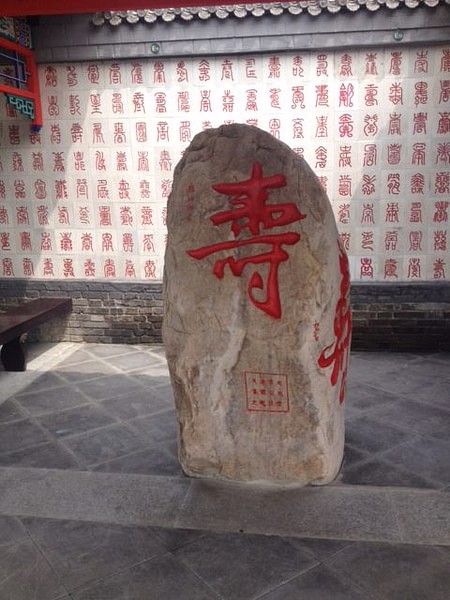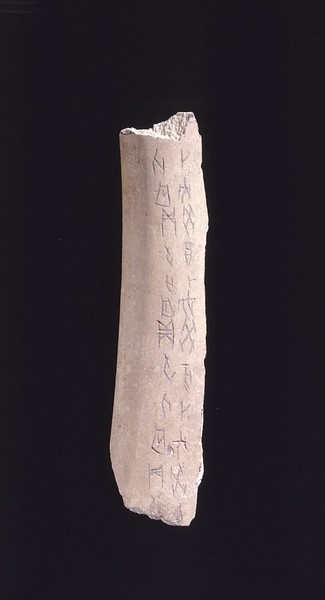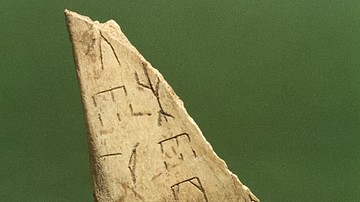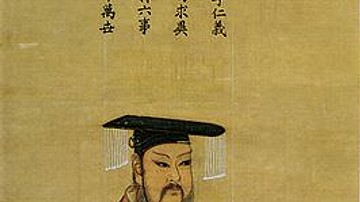
Ancient Chinese Writing evolved from the practice of divination during the Shang Dynasty (1600-1046 BCE). Some theories suggest that images and markings on pottery shards found at Ban Po Village are evidence of an early writing system but this claim has been challenged repeatedly.
Ban Po was occupied c. 4500-3750 BCE and was discovered by workmen digging a foundation for a factory in 1953 CE. Ceramic shards uncovered at the site have been classified into 27 distinct categories of image/sign which suggest to some scholars an early language. The opposing view is that these images are simply marks of ownership, comparable to making an X on a document to sign one's name, and cannot be considered an actual written language. The majority of recent scholarship agrees that writing evolved during the Shang Dynasty and developed from there. Scholar Patricia Buckley Ebrey expresses the consensus on this:
Exactly when writing was first used in China is not known since most writing would have been done on perishable materials like wood, bamboo, or silk. Symbols or emblems inscribed on late neolithic pots may be early forms of Chinese graphs. Early Shang bronzes sometimes have similar symbols cast into them. The earliest evidence of full sentences is found on the oracle bones of the late Shang. From these divinatory inscriptions, there can be no doubt that the Shang used a language directly ancestral to modern Chinese and moreover used a written script that evolved into the standard Chinese logographic writing system still in use today. (26-27)
Once writing was developed by the Chinese it had a significant impact on the culture. Ebrey writes, "In China, as elsewhere, writing once adopted has profound effects on social and cultural processes(26)." The bureaucracy of China came to rely on written records and, culturally, expression of personal thoughts and feelings was made possible through poetry and prose, creating some of the greatest literature in the world.
Oracle Bones
Oracle bones were the shoulder blades of oxen or the plastrons of turtles, scraped and cleaned, which were inscribed with marks for divination. The ancient Chinese were very concerned with knowing the future and would go to diviners for guidance on making decisions. The diviner (someone who today would be called a 'psychic' or a 'medium') would carve the person's question into the bone and then heat it with a hot poker or place it near a fire. When the bone would crack, the lines formed would be interpreted to answer the person's question.
An example of this might be whether the king should go hunting on a certain day. The diviner would carve the name of the king asking the question and the date it was asked. They would then carve the topic of the question (Hunting) and the specific question (Should king ___ go hunting tomorrow). The bone would then be heated, crack, and interpreted. Afterward, the prognostication would be inscribed (Yes, the king should go hunting tomorrow) and, later, the verification that the prediction was correct (King went hunting and was successful). Oracle bones were consulted by everyone in the Shang period from the lowest class to the highest.
Oracle bones continued in use through the Zhou Dynasty (1046-226 BCE) when they were replaced by another form of divination known as the I-Ching (The Book of Changes) which relied on a written text of hexagrams to interpret the meaning of a pattern made by the questioner throwing yarrow sticks onto a table. With both oracle bones and the I-Ching, the spirits of one's ancestors were thought to be influencing the divination and communicating directly with the diviner.
Evolution of Script
From these early beginnings, Chinese script evolved. These scripts were:
Jiaguwen - the earliest form of writing on Oracle bones used c. 1600-1000 BCE. This script was pictographic, meaning the inscription represented an object linked to a concept. Example: if one wanted to write "Should the king go hunting tomorrow?" one would carve an image of the king with his bow and sunrise.
Dazhuan - known as Greater Seal script, developed c. 1000-700 BCE. This was also a pictographic script but had many more characters and was more refined. The images were inscribed on bronze and probably wood.
Xiaozhuan - known as Lesser Seal script, developed c. 700 BCE and is still in use today. This script was less pictographic and more logographic, meaning the symbols represented concepts themselves, not objects. Example: if one now wanted to write "Should the king go hunting tomorrow?" one would inscribe the image for the king and the sign which represented 'hunting' and 'tomorrow'.
Lishu - known as Clerky Script, was developed c. 500 BCE and used during the Qin Dynasty (221 - 206 BCE) and Han Dynasty (206 BCE - 220 CE) extensively. Lishu grew out of the need for complete documentation of government affairs and, as the name indicates, was used by clerks in their work in governmental bureaucracy. Sentences were written on bamboo scrolls tied together with string. When one reads about emperor Shi Huangti (259-210 BCE) of the Qin Dynasty burning books, these are the kinds of books he destroyed. Paper was not invented until the Han Dynasty in 105 CE.
In addition to these scripts there also developed the cursive scripts used in poetry and calligraphy. These are: Kaishu (Standard Script) Xingshu (Running Script), and Caoshu (Grass Script). Caoshu developed during the Qin Dynasty while Kaishu and Xing during the Han period.
Legacy
As one can see, Chinese writing developed from pictures of objects which represented concepts to signs representing the concepts themselves. This development changed Chinese society and culture dramatically and also affected the way it would develop in the future. Ebrey explains:
It is essentially accidental that the Shang developed a logographic script rather than a phonetic script like most of those that became dominant elsewhere in Eurasia. This accident, however, had momentous consequences for the way Chinese civilization developed. It shaped the nature of the elite: the difficulty of mastering this script made those expert in it an elite possessed of rare but essential skills. (28)
On the positive side, this meant that as Chinese writing became more and more a part of Chinese trade, the culture spread to neighboring regions. As Ebrey notes:
Because the Chinese logographic script did not change to reflect differences in pronunciation, the literate elite easily identified with others whose writings they could read, including predecessors who lived many centuries earlier and contemporaries whose spoken languages they could not comprehend. Just as crucially, this script also affected the processes of cultural expansion and assimilation. People on the fringes of Chinese culture who learned to read Chinese for pragmatic reasons of advancing or defending their interests were more effectively drawn into Chinese culture than they would have been if China had had a phonetic script. Reading and writing for them could not be easily detached from the body of Chinese texts imbued with Chinese values, making it difficult for them to use their literacy to articulate the vision of a local population defined in opposition to China. (28)
The logographic script made a much more dramatic impression on readers than a phonetic script because people were not just reading words on a page but absorbing concepts directly as they read. On the negative side, the creation of a literate elite meant class divisions where those who could read and write were considered more valuable members of society than those who could not. This class distinction characterized Chinese society and history up until 1949 CE when Mao Tse Tung established the People's Republic of China largely in an effort to remedy social inequality.
Chinese script was adopted by Japan, Korea, Vietnam, became the basis for Khitan Script (Mongolia), Jurchen Script (of the Manchus), and the Yi Script of the indigenous people of Yunnan Province which differs from traditional Chinese script. It further influenced other nations of the region as seen in the Tangut Script of Tibet. Script enabled the Chinese, and then those of other nations, not only to communicate and keep records but also to create some of the most memorable works in world literature.








